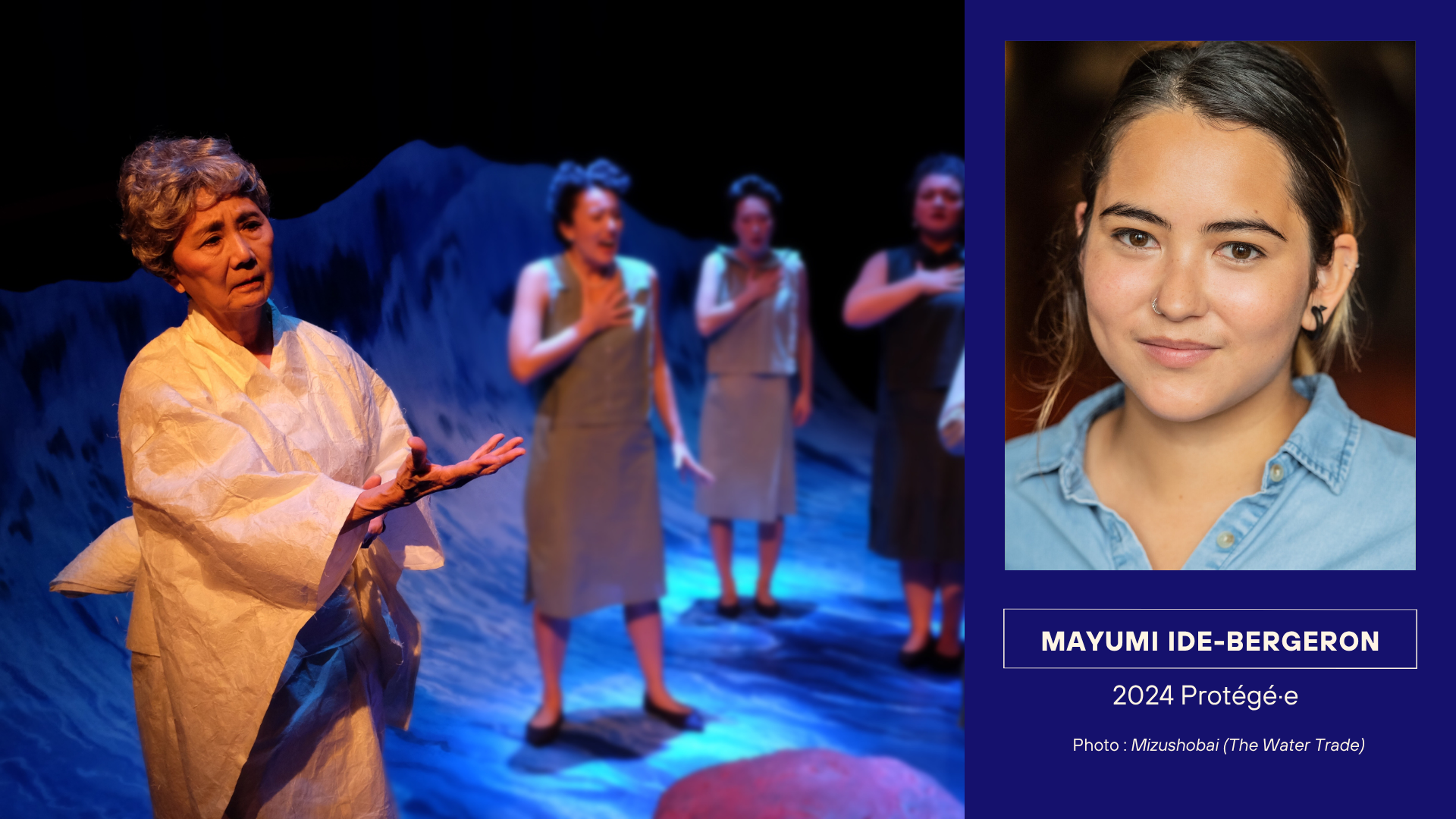Lately, Mayumi Ide-Bergeron has been thinking a lot about Tinkerbell. She’s assisting props designer Karine Cusson on a new production of Peter Pan the Musical, and they’ve been assigned “La Fée Clochette,” as the iconic sprite is known in French. She tells me she has rewatched all the Tinkerbell made-for-TV movies – who knew there were any – and she’s struck by Tink’s penchant for bricolage. “She tries to build things out of random objects to create something useful,” she explains. “She’ll create a car out of nuts and just build something out of trash.” As someone with a lifelong love of making things with her hands, Ide-Bergeron can relate.
Childhood summers spent with her grandmother in Bayfield, Ontario often included a family trip to the nearby Stratford Festival, and she credits a 2015 production of Taming of the Shrew with sparking the idea that she could combine her love of visual arts with theatre to make a career. After a couple of years at the Collège Lionel-Groulx in Sainte-Thérèse, she was admitted to the National Theatre School in Montreal. That’s where she lives now, working, somewhat unusually, in both French and English theatre. Doing the best job in the world, as she puts it: “I get to do craft and art. To create a magical piece with a bunch of new people?” Nothing better.
English and French theatre practice can be quite different, even down to how they handle props. Often, in English theatre, one designer is assigned both set and props, whereas in Québec, it’s more common for props to get their own, dedicated designer. “I’ve been called to do prop design because the set designer says specifically they don’t want to do ‘the little things’,” Ide-Bergeron says with a laugh. She designs set and costumes too, but she has an evident affinity for props. Even her student set design project at [National Theatre School] had a prop-ish quality. At first glance, it was a kitchen, but it was full of details that transformed in unexpected ways: a spice rack became a ladder, for example, and a pantry door turned into a bathroom. Since her schooldays, her eye for detail has only increased. She shares that recently, she was watching a hospital show on TV with her mom, and she noticed all the binders on the administrator’s office shelves were empty.
Ide-Bergeron is inspired by multi-disciplinary theatre designers like Cédric Lord, who runs Le Salon Particulier in Montreal, a combo of woodshop, rehearsal space, art gallery, and gathering spot. “My dream office would have prop storage, all the tools I need, a lot of everything,” she fantasizes. “I’m a maximalist for props and a minimalist in every other aspect of my life.”
That minimalism is no doubt influenced by her commitment to sustainable design. “I love talking about eco-design,” she enthuses, “I’m a city girl, but I feel the most alive when I’m in the forest, hiking.” At NTS, she took a class with sustainable practices leader Anne-Catherine Lebeau, which led to a job as a researcher at Lebeau’s organization Écoscéno, a company that consults with arts companies on how to reduce their environmental footprint. That experience opened her eyes to the many wasteful aspects of conventional theatre production, with its resource-intensive, short-term builds that get tossed in the dumpster the day the show closes. Now she thinks about environmental impact right from the beginning of her process, researching sustainable materials, breaking her design down into reusable structures, and trolling through thrift stores and markets “with a prop in mind, thinking, how can I do stuff with the things I already have?”
In the future, Ide-Bergeron would love to travel for work, and hopes to expand her practice to include circus and dance, more costume design, and in general, “learning as many things as I can.” She is currently looking into paper-making, for example, which she plans to pursue during an upcoming trip to Japan. She is travelling with her Siminovitch mentor, Sonoyo Nishikawa, who promises to introduce her to theatre-makers there. They’ll be accompanied by 2015 Siminovitch Laureate Annick Bissonnière, another connection made since Ide-Bergeron was named Protégé by Nishikawa.
She relishes the opportunity to spend more time with Nishikawa in Japan, and during a two-week residency in Banff this fall, offered by the Siminovitch Foundation in partnership with the National Arts Centre and the Banff Centre for Arts and Creativity. She recalls: “I remember seeing [Nishikawa’s] name in the credits for a show I’d been hired for, and thinking, that sounds like a Japanese name, and getting really excited. She was on my way home from the theatre; sometimes I’d give her rides, and we got to talk. When I found out she was nominated I was extremely excited for her, but I never thought she’d name me. I’m a lot less shy to contact her now. We went to a few plays, and now we’re planning our trip.”
People are a big part of what Ide-Bergeron loves about theatre. When asked how her collaborators might describe her, her thoughts circle back to Tinkerbell. “I’m good at problem-solving with the means that I have,” she muses, “but I like learning new things. I’m always tinkering.”
Mayumi Ide-Bergeron was selected as Siminovitch Theatre Foundation Protégé by 2024 Laureate Sonoyo Nishikawa.
Vanessa Porteous is a theatre artist, filmmaker, and writer based in Calgary. From 2018 to 2021 she was Jury Chair for the Siminovitch Theatre Foundation prize.
Mizushōbai (The Water Trade) at the Segal Centre Studio Space
Photo: A J Korkidakis
Playwright: Julie Tamiko Manning
Director: Yvette Nolan
Set Designer: Jawong Kang
Costume Designer: Mayumi Ide-Bergeron
Lighting Designer: Zoë Roux
Sound & Composition: Christine Lee
Graphic Design: A J Korkidakis
Cast: Yoshie Bancroft, Hanako Brierley, Brenda Kamino, Katelyn Morishita, Dawn Obokata
